#buddhist practice
Text

Upali (Ref) – Buddhsit practice in mountain forests
When Upali, one of Buddha's ten great disciples, asked Buddha's permission to enter the mountain forests to practise,
Buddha said, “Upali, there was an elephant bathing in a large pond. The elephant was washing his body, washing his back, washing his ears, and he was very happy. Seeing this, the rabbit also entered the pond, but his small body became afraid of the water and he jumped out. You are not fit for mountain forest training, O Upali. You should practise among the people." He advised him to do so. - (Samyutta Nikaya 99)
Upali was a barber of Buddha’s birthplace before he was ordained. Thus, he probably had a gregarious personality. It is an incredible pain for such a personality to live a solitary life deep in a mountain forest. Therefore, the Buddha advised Upali to be among the people and to practise.
The Buddha encourages those who are fit to practise in the mountain forests to do so. The Buddha gives guidance appropriate to each person according to his or her personality. That was the Buddha’s way.

ブッダから弟子たちへ、ミニシリーズ (9)
優波離(ウパーリ 参照) 〜 山林での修行
ブッダの十大弟子の一人、優波離が山林に入って修行したいとブッダに許可を求めたとき、
ブッダは「優波離よ、大きな池で象が水浴びをしていた。身体を洗い、背を洗い、耳を洗い、まことに楽しげであった。それを見て、兎もまた池に入ったが、小さな身体で水が怖くなり、飛び出してしまった。優波離よ、そなたには山林の修行は適していない。そなたは衆生の中で修行するがよい。」と、そのように助言された。― (相応部経典 99)
優波離は出家する以前、ブッダの生国の理髪師だった。したがって、彼はたぶん人懐い性格だったと思われる。そんな性格の人間が、山林で孤独な生活をするのはすごい苦痛だ。だから、ブッダは優波離には、人々のあいだにあって修行することを勧めた。
ブッダは、山林での修行がふさわしい人には、それを勧めている。ブッダは相手の性格に応じて、それぞれにふさわしい指導をされている。それがブッダのやり方だったのである。
#zen#mindfulness#buddhism#buddha#buddha's 10 great disciples#upali#wisdom#philosophy#nature#art#buddhist practice
127 notes
·
View notes
Text
Dharma is a destructive or deconstructive process. Some examples:
• By removing busyness and agitation, there is natural peace.
• By removing endless desires, there is natural satisfaction.
• By removing self-centredness, there emerges a natural awareness of others and care for them.
• By removing illusions, there is natural lucidity about things.
• By removing fear of loss and stinginess, there is natural generosity.
- Ken Holmes (Kagyu Samye Ling Dharma Study Programme)
30 notes
·
View notes
Text
Any practice that helps you, is by its nature a good practice.
It doesn't matter if it originates from a different school of the Dharma or if it is something you have come up with yourself, because the Dharma does not have a boundary.
If it is done in the spirit of seeking truth, and alleviation of suffering then it is a good practice.
29 notes
·
View notes
Text
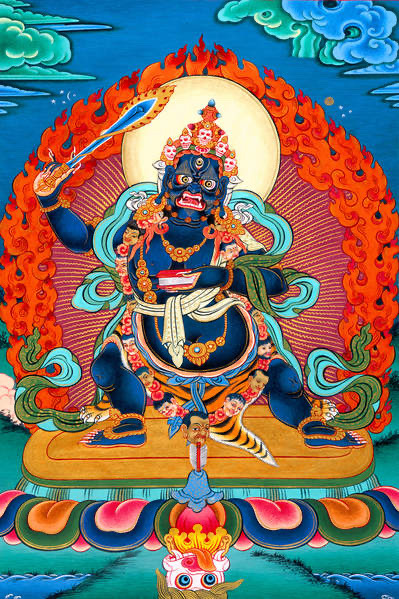
Gnostic Commentary on a Buddhist Text:
On a certain day when the Buddha dwelt at Jetavana, a celestial deva (angel, master) came to him in the shape of a Brahman (priest), whose countenance was bright and whose (inner) garments (solar bodies) were white as snow (due to his perfect chastity).
The deva asked the Buddha, "What is the sharpest sword? What is the deadliest poison? What is the fiercest fire? What is the darkest night?"
The Buddha replied, "A word spoken in wrath is the sharpest sword (because it cuts both speaker and hearer); covetousness is the deadliest poison (because poison kills the entire body, not just the mouth that ingests it); hatred is the fiercest fire (the agony of hatred burns without rest); ignorance is the darkest night (lack of gnosis is the deepest suffering)."
The deva asked, "What is the greatest gain? What is the greatest loss? What armor is invulnerable? What is the best weapon?"
The Buddha replied, "The greatest gain is to give to others (this is the law of the Christ); the greatest loss is to receive (Kabbalah) without gratitude (those who receive wisdom and horde it, or who corrupt it, suffer the greatest loss, because the Christ will never incarnate in them). Patience is an invulnerable armor (patience is the secret key to initiation, and with it, one can never be harmed by any ordeal); wisdom (Chokmah, Christ) is the best weapon."
The deva asked, "Who is the most dangerous thief? What is the most precious treasure?"
The Buddha replied, "Unwholesome thought is the most dangerous thief (the mind is our worst enemy); virtue (vir- comes from virility: sexual potency) is the most precious treasure."
The deva asked, "What is attractive? What is unpleasant? What is the most horrible pain? What is the greatest enjoyment?"
The Buddha replied, "Wholesomeness (that which is in accordance with the Law; that is, it is whole in Christ) is attractive; unwholesomeness (that which is contrary to the Law) is unpleasant. A bad conscience is the most tormenting pain (that is, a consciousness trapped in evil deeds); awakening the height of bliss (ecstasy, samadhi, the clear perception of the awakened bodhicitta)."
The deva asked, "What causes ruin in the world? What breaks off friendships? What is the most violent fever? Who is the best physician?"
The Buddha replied, "Ignorance (lack of gnosis / da'ath) causes ruin in the world; envy and selfishness break off friendships; hatred is the most violent fever; the (inner) Buddha is the best physician." (These are the three poisons which are the axle of the wheel of suffering.)
The deva then continued, "Now I have only one doubt to be cleared away: What is it fire cannot burn, nor moisture corrode, nor wind crush down, but is able to benefit the whole world?"
The Buddha replied, "Blessing! Neither fire, nor moisture, nor wind can destroy the blessing of a good deed (right action); and blessings benefit the whole world." (Therefore, learn how to embody right action: the will of the Inner Buddha as performed by his human soul: Tiphereth.)
Hearing these answers, the deva was filled with joy. Bowing down in respect, he dissapeared suddenly from the presence of the Buddha. —The Sharpest Sword
#buddha#buddhist#buddhanature#buddhism#mindfulness#living mindfully#being mindful#mindful meditation#mindful living#mindful#spirituality#gnosis#meditation#consciousness#chicago gnosis#psychology#buddhist practice#buddhist philosophy#spiritual#awakening#spiritual exercises#spiritual awakening#spiritual quotes#spiritual enlightenment#spiritual development#samael aun weor#gnostic academy of chicago#chicago gnosis podcast#the buddha#religion
9 notes
·
View notes
Text

It’s Mindful Monday! If you haven’t been mindful today, here’s your reminder to breathe deeply and be in deep presence with self.
One mindful activity I did today was some yoga (my shoulders and neck sorely need it!) but a certain someone kept joining in and licking the mat!! So I ended up practicing upstairs. But what a lovely quiet moment this bank holiday to stretch and get in touch with my body 🥰
#mindful monday#mindfulness#mindful practice#yoga#mindful movement#wellness#wellbeing#mindful living#plum village#self care#meditation#self love#mental wellbeing#buddhist practice#buddhist teachings#buddhist philosophy#buddhism
7 notes
·
View notes
Text
Book of the Day - The Art of Happiness
Today’s Book of the Day is The Art of Happiness, written by His Holiness The Dalai Lama in 1998 and published by Riverhead.
Jetsun Jamphel Ngawang Lobsang Yeshe Tenzin Gyatso (born Lhamo Döndrub), the 14th Dalai Lama, is the leader of Tibetan Buddhism since 1950 and also the leader of the Tibetan Government in Exile after the Chinese invasion of Tibet in 1959, and a Nobel Peace Prize Laureate…
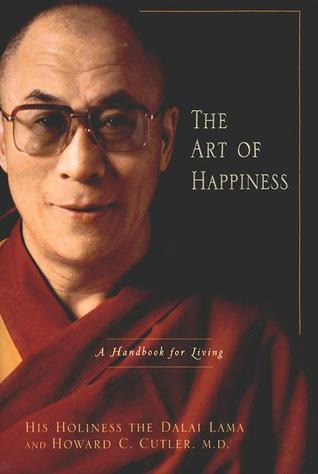
View On WordPress
#anger#Anxiety#behaviours#beliefs#book recommendation#book review#bookstagram#booktok#Buddhism#Buddhist practice#Dalai lama#fear#Free Tibet#Gelug Buddhism#Happiness#meditation#mindfulness#motivations#Nobel Peace Prize#Nobel Peace Prize Laureate#peaceful spirit#perspective#Psychology#Raffaello Palandri#Tenzin Gyatso#Tibet#Tibetan Buddhism#Tibetan Government in Exile
2 notes
·
View notes
Text
37 Ancient Lost Texts on Buddhism
The Lost Book Project charges $7 for this collection. If you found this roundup useful, please consider donating to the Internet Archive instead.
Other roundups here
The Manual Of Zen Buddhism by D. T. Suzuki (1921)
The Light of Asia by E. Arnold (1894)
A Buddhist Bible by D. Goddard (1921)
Dhammapada And The Sutta Nipata by F. M. Muller (1881)
31 Planes Of Existence by Jinavamsa (1891)
Esoteric Buddhism by A. P. Sinnett (1889)
The Dhammapada, a Collection of Verses; Being One Of The Canonical Books Of The Buddhists by Max Muller (1881)
Buddha and Buddhism by Arthur Lillie (1900)
The Gospel Of Buddha by P. Carus (1917)
The Questions Of King Milinda Pts. 1 & 2 by T. W. Rhys Davids (1890)
The Tree Of Wisdom by Nagarjuna (1919)
A Buddhist Catechism by H. S. Olcott (1908)
A Record Of Buddhistic Kingdoms by J. Legge (1886)
Buddha His Life, His Teachings by M. N. Shastri (1901)
Buddhist Mahayana Texts Pts. 1 & 2 by E. Cowell (1894)
Buddhist Suttas by T. W. Rhys Davids (1881)
Early Buddhism by T. W. Rhys Davids (1908)
Eastern Stories and Legends by M. L. Shedlock (1920)
Nirvâna - A Story of Buddhist Psychology by P. Carus (1902)
Sermons Of A Buddhist Abbot Zen For Americans by S. Shaku (1906)
Buddhist Scriptures by E. J. Thomas (1913)
The Buddhist praying-wheel - a collection of material bearing upon the symbolism of the wheel and circular movements in custom and religious ritual by W. Simpson (1896)
The Dhammapada by Suriyagoda Sumangala Thera (1914)
The Essence of Buddhism by P. Lakshmi Narasu (1907)
The Gateless Gate by Ekai, called Mu-Mon (1921)
The Gods of Northern Buddhism by A. Getty (1914)
The Jataka or stories of the Buddha's former births Vols. 1, 2, 3 & 6 by E. B. Cowell (1895)
The legends and theories of the Buddhists, compared with history and science, with introductory notices of the life and system of Gotama Buddha by R. S. Hardy (1866)
The Life Of Buddha by A. F. Herold (1922)
The life of the Buddha and the early history of his order by W. W. Rockhill (1907)
The life, or legend, of Gaudama, the Buddha of the Burmese Vol. 2 by P. Bigandet (1911)
Ed note: Both volumes because I love you <3
The Saddharma Pundarika by H. Kern (1884)
The Soul Of a People by H. Fielding (1902)
The Way Of The Buddha by H. Baynes (1913)
The Way to Nirvana by L. de la Vallée Poussin (1917)
The wheel of the law. Buddhism, illustrated from Siamese sources by the Modern Buddhist, a Life of Buddha, and an account of the Phrabat by H. Alabaster (1871)
The word of the Buddha; an outline of the ethico-philosophical system of the Buddha in the words of the Pali canon, together with explanatory notes by B. Nyanatiloka (1907)
2 notes
·
View notes
Note
I had some questions for you: when it comes to chanting with the 108 mala beads what has your experience been like with them? Does it matter what type of material is used and what kind has benefited you most? Is there a certain way you hold your mala when you count? The last question is because I'm looking up if there's a "right" way to hold and count from the mala and in Hinduism they hold it between the thumb and the middle finger because the fingers represent the elements: thumb = earth, index = fire and middle = the sky. So the index finger is excluded since it would be like burning the earth. When you count to the last bead you flip it so that it becomes the starter bead instead of crossing over the Guru bead. Does Buddhism follow the same thing or is it more open ended? Also when you dedicate the blessings to the ancestors is it after each cycle is done (ex. 1 cycle you pause say "I dedicate this cycle of blessings to xxx" resume another cycle) or after a complete session (ex. 7 cycles done so you would ask all that you accumulated goes to them). P.S. in the process of sorting ancestor stuff so I really don't wanna mess up to ensure they get the blessings. Thanks in advance 🙏
Hello there!
Yes, there are right ways to use a mala, however the “right way” does depend on what tradition you follow, because there are many traditions within Buddhism. Therefore it’s hard to give you a definite answer. In my tradition, we hold it in the left hand (other traditions say you must hold it in the right hand). We also never count over the guru bead, as you said, we flip the mala and count the other way. We pull the beads towards us with our thumb, so that we are pulling in the siddhis (benefits) towards us.
Different materials are associated with different benefits, but always made from natural, durable materials which are evenly shaped and sized. You can have whatever kind you like, and as many as you like. You can dedicate them to different practices and deities, or use one mala for all of them. The number of mala beads is usually 108 but you can get them as small as 54 or 27 beads, though we always chant 108 recitations at a time. One mala = 108 recitations. In my tradition it’s fine to count on the index finger, and different fingers are also associated with different activities: pacifying, increasing, destroying obstacles, etc.
That said, there are very different expectations for laypeople compared to initiates and clergies/priests. So I think (assuming you are a layperson) you do not need to worry too much about the specifics, just practice with respect and sincerity until you find a teacher (you can do so online, there are many gurus/lamas who have an online presence). And once you find a teacher that speaks to you, you follow the traditions as laid out by them. This applies to most aspects of Asian traditions, everything is done according to your teacher/lineage.
As for how to practice respectfully, the essential thing is to always keep your mala clean: never place it on the floor, your feet, or anywhere dirty. Hide it (such as in a cloth bag) when you enter the restroom or when travelling so that it doesn’t get dirty. It’s best to avoid letting other people touch your mala as well, unless they are of the clergy (in which case they can bless your mala). There are people who just wear mala as jewellery, but if you’re dedicating yours to religious/spiritual/magical practice it should be treated as a sacred object. Also make sure your hands and mouth are clean prior to practice, including after sexual activity or touching/consuming meat. If your mala gets dirty, you can cleanse it by rinsing it with water and wiping with a clean cloth and/or passing it through incense.
It’s great to get your mala blessed by the clergy, but the mantras themselves also cleanse and bless. It’s also great to meditate before and after reciting, and make or visualise offerings to the deity. But really, the most important part – the part that truly matters – is just to recite the mantra.
The mantras are the deity in sonic form; they are a direct invocation of the deity and their power (which is why many mantras are initiation-locked, and practicing a closed mantra without initiation is a bad idea). You can chant as many malas in one session as you like and dedicate the merits all at the end. Don’t worry so much about messing up, just recite the open mantras and pray for what you need, the gods are there to help you!
Best wishes to you and your ancestors 💚
10 notes
·
View notes
Text
He had always wanted to visit Da Nang because of its easterly facing location and its connection to the water.
image of Golden Bridge & Ba Na Hills

I know a Buddhist influence is with us.
To know this makes me happy.
1 note
·
View note
Text
Die Drei Juwelen - erste Überlegungen
Buddha (der Lehrer und die Nachfolger), Dharma (die Lehre selbst) und Sangha (die Gemeinde der Praktiker) erschließen sich mir auf den ersten Blick.
Bei der Verehrung dachte ich zuerst, dass ich hiermit Verbindungsprobleme haben könnte, aber je länger ich darüber nachdenke, desto eher möchte ich es einfach auf mich zukommen lassen und erfahren.
Ich glaube, mir steht im Weg, dass ich mich für einen Buddhismus entscheiden möchte; die Eleganz des Zen und meine Bewunderung des Dalai Lama behindern mich.
Ich werde versuchen, alles auf mich zukommen zu lassen.
In Reaktion auf Buddhismus für Dummies
#Buddhismus#Buddhist#buddhist practice#Thema: Die Drei Juwelen#Spiritualität#studyblr#study blog#deutsche blogs#deutscher blog#Masterliste#Thema: Verehrung#Buch: Buddhismus für Dummies
1 note
·
View note
Text
GEORGE LUCAS: I think there is a point where, even though you love your children a great deal, you must let go, which is actually what “The Phantom Menace” is about.
BILL MOYERS: “The Phantom Menace” is about letting go?
GEORGE LUCAS: It’s about letting go.
BILL MOYERS: In what sense?

GEORGE LUCAS: In the sense that you have this young boy, who’s 10 years old, who has to leave his mother and go off on his own and the mother has to let him go because otherwise he would be a slave the rest of his life.
GEORGE LUCAS: At some point you do have to become an independent person. And it’s about learning to let go of your — your needs, so to speak, and — and think of the needs of others.
#shmi skywalker#anakin skywalker#letting go#star wars#George lucas#I'll call Shmi Skywalker “lay Jedi” from now on#you know#like “lay Buddhists” practicing the Jedi Way at home
406 notes
·
View notes
Photo
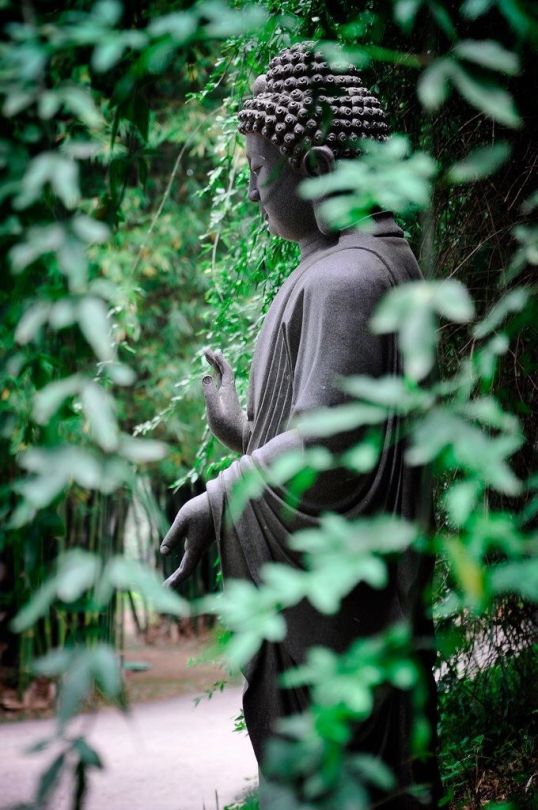
The Quest for Buddhism (102)
Buddhist cosmology
Bhavana – Training of the mind, mastery of the 4 rupa-jhana (Ref1)
Bhavana literally means "development" or "cultivating" or "producing", in the sense of "calling into existence" in Pali and Sanskrit. It is an important concept in Buddhism as a practice (Patipatti).
The word bhavana is sometimes translated as 'meditation' so that, for example, metta-bhavana may be translated as 'the meditation on loving-kindness'. Meditation is properly called dhyana (Pali: jhana Ref), as practiced in samadhi, the 8th limb of the eightfold path (Ref2).
In the Pali canon, bhavana appears in the form of idioms in the context of long-term personal efforts for the development of specific abilities, such as mind and compassion. For example, in the Pali canon and the composite scriptures, the following terms can be found:
citta-bhāvanā, translated as "development of mind" or "development of consciousness."
kāya-bhāvanā, translated as "development of body."
mettā-bhāvanā, translated as the "cultivation" or "development of benevolence."
paññā-bhāvanā, translated as "development of wisdom" or "development of understanding."
samādhi-bhāvanā, translated as "development of concentration."
In addition, in the Canon, the development of samatha meditation - vipassana meditation (bhavana) is recommended. Subsequently, Theravada teachers have made use of the following compounds:
samatha-bhāvanā, meaning the development of tranquility.
vipassanā-bhāvanā, meaning the development of insight.

仏教の探求 (102)
仏教の宇宙論
心の訓練 (バーヴァナー) 〜 四禅 (参照1) の修得
バーヴァナーとは、パーリ語またサンスクリット語で、発達、育成、生産を意味する語句であり、生活における活動という意味合いである。仏教においては実践 (パティパッティ)として重要な概念である。
バーヴァナーという言葉は「瞑想」と訳されることもあり、例えばメッタ・バーヴァナーは「慈愛の瞑想」と訳されることがある。瞑想は、正しくは禅定 (梵: デイヤーナ、巴: ジャーナ 参照) と呼ばれ、八正道(参照2)の8番目の肢(え)である三昧 (さんまい、梵: サマーディ)で実践されるものである。
パーリ仏典では、「バーヴァナー」は、心・慈など特定の能力を開発するための長期的な個人の努力という文脈で、慣用句の形で登場する。例えば、『パーリ語大全』や『複合経典』には、次のような用語がある:
シッタ・バーヴァナー:「心の発達」、「意思の発達」と訳される。
カーヤ・バーヴァナー:「身体の発達」と訳される。
メッタ・バーヴァナー:「慈を修めること」、「慈の発達」と訳される。
パンニャ・バーヴァナー:「知恵の発達」、「理解の発達」と訳される。
サマーディ・バーヴァナー:「集中力の発達」と訳される。
また経典においては、サマタ瞑想-ヴィパッサナー瞑想の発達(バーヴァナー)が推奨されている。そのため上座部仏教のテキストでは以下の語句が使われてる:
サマタ・バーヴァナー: 静けさの発達を意味する。
ヴィパッサナー・バーヴァナー: 洞察力の発達を意味する。
#bhavana#the 4 rupa-jhana#meditations#mindfulness#buddhism#nature#pali cannon#patipatti#buddhist practice#smatha#vippasana#philosophy#buddhist cosmology#art
134 notes
·
View notes
Text
"Despite what you think, you are not free. I’m not saying that you are under the control of someone else. It’s your own uncontrolled mind, your own attachment that oppresses you. If you discover how you oppress yourself, your uncontrolled mind will disappear. Knowing your own mind is the solution to all your problems."
- Lama Thubten Yeshe
160 notes
·
View notes
Text
You don't know how much I want this character. You don't understand but I just gotta ask
Is This ATSV Character Thai?
aka a crash course in Thai tattooing and Buddhist tradition


Please correct me if I'm wrong - but I was really interested in her tattoo.
And looking at the tattoo they singled out beside her - it made me question:
Is that a Traditional Thai tattoo? Is that supposed to be Sak Yant?
And immediately I saw the opportunity to infodump about Buddhism and Thai cultural tattooing! (And my personal experience with it)
It makes me think that maybe this character was meant to me Thai - because her tiger tattoo resembles the twin tiger Sak Yant tattoo.
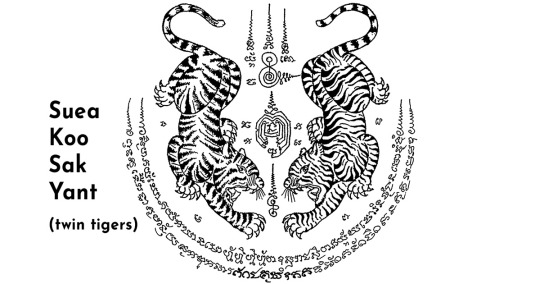
If you're unaware, Sak Yant is a type of traumatic tattoo native to Thailand.
Connected deeply to the Buddhist faith, Sak Yant tattoos are specific designs that are claimed to have spiritual power.
Typically done with a traditional needle and stick rather than a machine, Sak Yants are tattooed by a Thai Buddhist teacher, an Ajarn.
Each Sak Yant design grants the wearer fortune, protection, or a virtue relating to a Buddhist value.
Each Yant comes with conditions though.
In order to preserve the spiritual power of the tattoo, the wearer just act in accordance to certain standards of Buddhist teaching - simple things like no murder, no adultery/cheating, no lying, etc.
They say if you do these things, your Yant becomes useless over time.
Many Muay Thai fighters have many Sak Yants, typically for protection - which could be the reason she's wearing herself.

However, that doesn't necessarily mean that she's Thai - for one, the tattoo might not be a Sak Yant.
It doesn't exactly match a true Sak Yant design, however, it's fairly close.
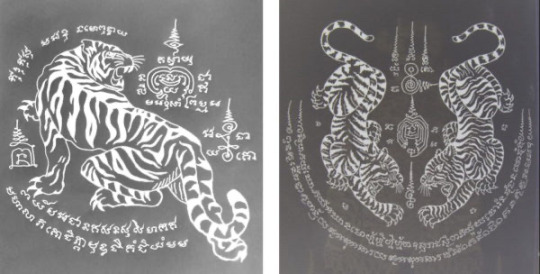
It seems as if the creators mixed the Suea Liaw (left) and Suea Koo Maha (right) designs, combining them to form the unique design for the character.

This would be an interesting choice.
The Twin Tigers are one of the favorites of Muay Thai, as it represents protection, power, and authority, which could be useful to sometime working a bar like her.
However, it also seems similar to the Yant 'Suea Leaw Lung' - tattoo similar to Suea Liaw - except with a raised paw, much like hers. Leaw Lung is said (grain of salt unless you're hearing from a Ajarn though) - to bring positivity and safety to those struggling in life.
So the tattoo might not be a Sak Yant - or it could be a Yant style created specifically by the creators of ATSV (as they may have wanted to avoid using a real one, as they're really hard to do unless you're an Ajarn and know the symbols and language).
And also, not everyone who gets one is Thai - though many who get it are Buddhist.
Like me!
Angelina Jolie is popular for the number of Yants she has on her back.

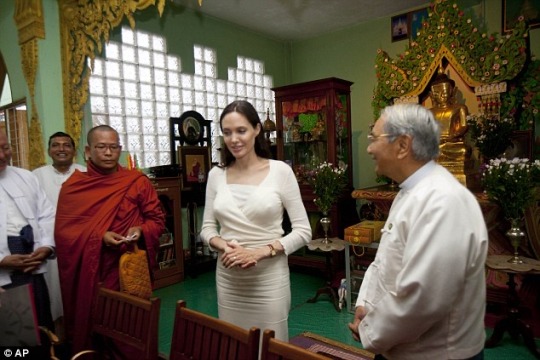
Angelina is in fact a Buddhist and has raised her children within the religion*.
She, like most other Buddhists, got hers done traditionally, under the hand of a Ajarn.
The one in the center of her back - is actually the one I have as well.
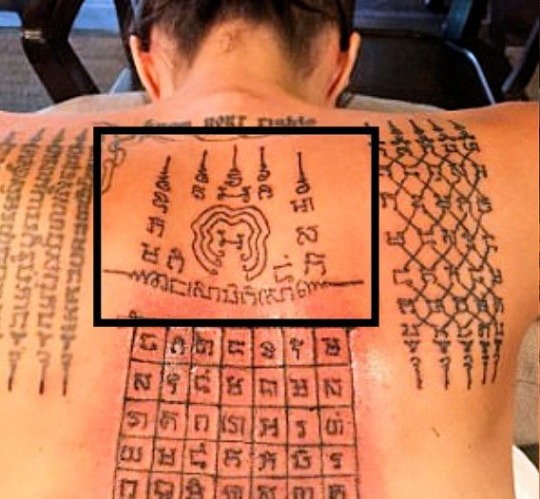
(Angelina's back after her 5th Yant)
Religiously, I am a Theravada Buddhist - though I more focus on the Plum Tree Tradition of Thigh Nhat Hanh.
Theravada Buddhism is the type most prevalent in South East Asia, in contrast with the Nepali and Tibetan Mahayana - which the Dhali Lama belongs to.
I got my Sak Yant done under the hand of an Arhat as well, traditional needle style about 3 years ago in Chiang Mai (Northern Thailand)
The one I have is Yant Putsoorn - the 5 Buddhas yantra.

Although there are many vague ass descriptions of what each Yant means online - my Ajarn personally told me Putsoorn is aimed at raised compassion mindfulness towards yourself and others as well - usually known as loving-kindness.
So she could be specifically Buddhist as well, if the tattoo is supposed to be Yant.
I think the idea is so so cool, because you may see traditional Japanese tattoo designs, many breathtaking , but it's rare you see other forms of traditional tattoo in day to day media!
I really really want to see her in action now! Just to see that tattoo up close. Plus she's so bad-ass!
I was SO SO SO excited to see her tattoo, and I really hope it is one! More Buddhist characters please. You can be hardcore and Buddhist too!
But does anybody have any other theories of what this tattoo could be? Do you know why traditional designs outside of Yant that this could be? Do you agree this could be Yant?
I'm curious!!
* Just a bonus: I wanted to highlight my use of the word religion in reference to Buddhism. Often in the West, Buddhism is reduced to a 'philosohy' or 'a way of life' rather than a legitimate religion. This is reductive. Buddhism is a religion, with monks, nuns, plains of existence, 'heavens' (very different context than Abrahamic - being reborn in heaven actually makes it harder to reach nirvana, because you are tempted by more comfort. Being born on Earth is the easier way to reach nirvana). Buddhism has ceremonies and centuries worth of text and practice - like Sak Yant. Although it is centered in mindfulness, acceptance, and love - and these teachings can be used by anyone regardless of religion - Buddhism is a religion. Just one far removed from the western Abrahamic understanding of religion. You can read and encorporate any of the teachings, it's very very very open. There are no borders between people, and any heart that is open or desiring it can engage with Buddhism as much or as little as they need to. But I think it's important to refer to Buddhism as a religion so the world conversation on religion isn't centered on Abrahamic, Western ideals and history - when in fact there are many loving, kind, and rich religions out there. From Hoodoo, to Sikhism, to Buddhism and beyond :)
#we NEED a Thai spider please!!!#ISN'T THIS SO COOL ISN'T IT#WE GETTING ENLIGHTENED IN HERE#For those curious I'm a ancestoral worshipper (which is common in Theravada)#Spiritually I practice Hoodoo - Religiously I am Buddhist#no proofread lolol#spiderman#atsv#spider man#marvel#across the spiderverse#beyond the Spiderverse#mauro belfiore
113 notes
·
View notes
Note
Ur Ukrainian!!! Omg, are u making perogis for Christmas too?? If so, which ones are u making?
no i don’t celebrate orthodox christmas. my moms side of the family is very ukrainian (my great aunt and grandpa immigrated to the us after ww2 and my other grandma was born here at the beginning of ww2 to a ukrainian ambassador) and my great aunt does the whole traditional christmas eve dinner so that’s what we celebrate.
tho it’s not like all the dishes, she’s scaled it down over the years so we do the borscht with ushka, fried flounder, baked salmon with dill sauce, holupchi (sorry for the spelling) with mushroom sauce, regular potato pierogis and sauerkraut pierogis and a fuck ton of dessert. but there used to be i think like 2 more fish dishes.
my earliest memory is actually spitting out an ushka when i was 2 on christmas eve and my uncle making the most outraged face at me from across the table. baby saph didn’t like mushrooms aparently.
but merry christmas!! i’ll eat some of my pierogis on orthodox christmas in honor of all my fellow ukrainians out there :) if i can fucking make dough that cooperates
#tho my great aunt was telling us that all the people she knows in ukraine aren’t celebrating orthodox christmas this year#cause they don’t want to be associated with russia#which is fair#aparently they all did it on the 25th#anywayyyy#very funny tho brad is the more religious one of us two#he’s a practicing buddhist and i only celebrate christmas for the vibes basically#and i was like listen do whatever you want but we have to absolutely celebrate christmas eve and this is non negotiable#he hasn’t tried all the food yet#he’s had pierogis and cutia and liked them both tho so i am hopeful#not a tag#from saph
130 notes
·
View notes
Note
what do you mean there's a buddhist calendarrrrrrr i didnt knowww i swear i went to the temple weekly as a kid
WAIT DID YOU HAVE THIS AT HOME

it has like waxing and waning day and the important date like vesak somthing like that? quick what year is this
#haiii tidesss#oceancore#i’m intrigued i wanna know buddhist practices in other countries#thank you for the ask!!#jrrasks
17 notes
·
View notes